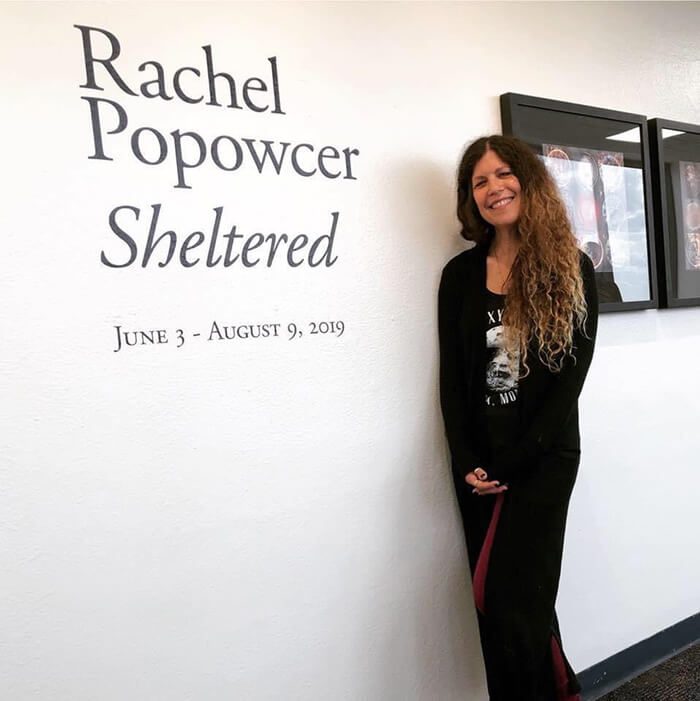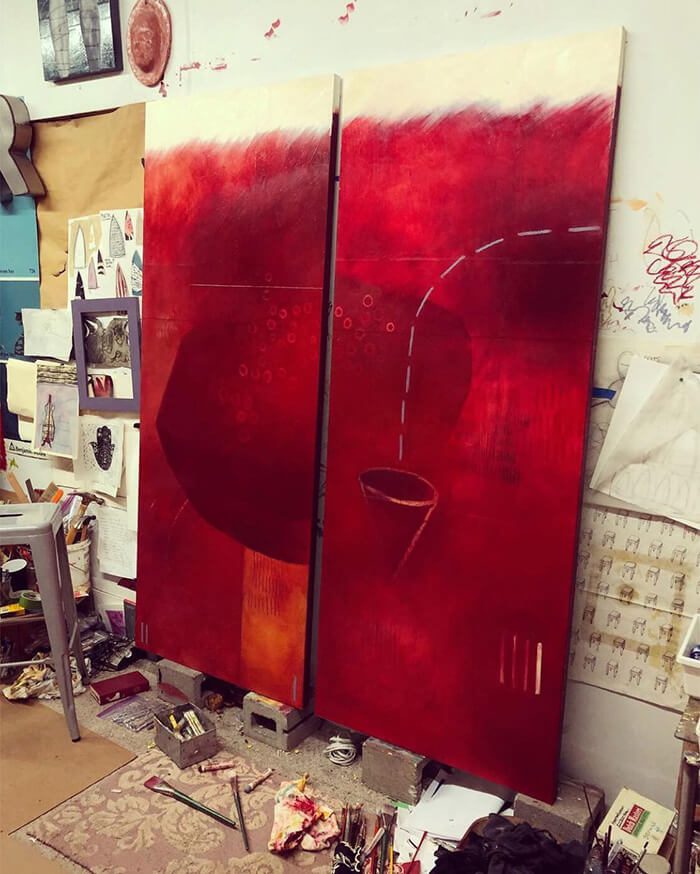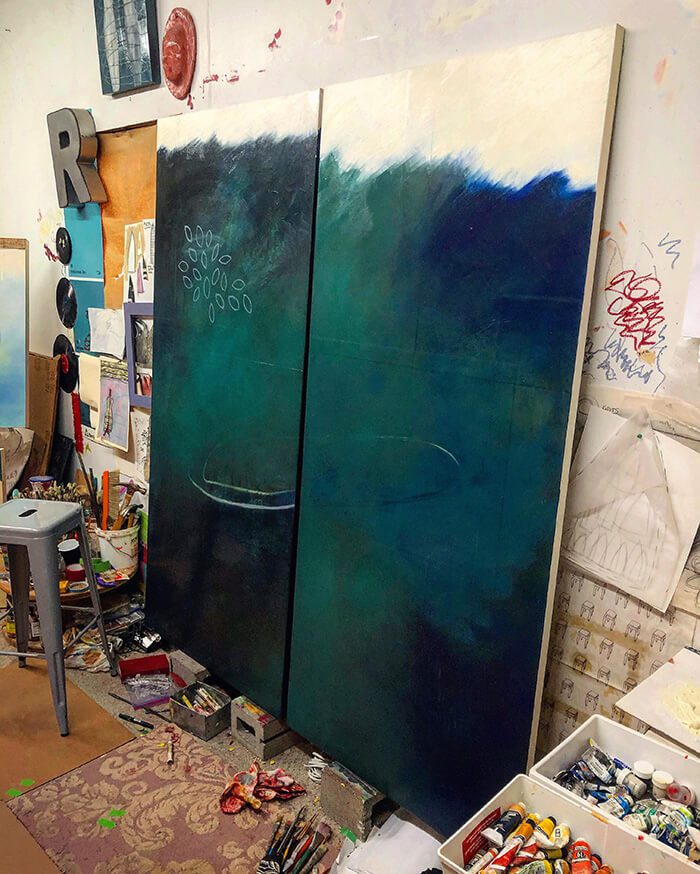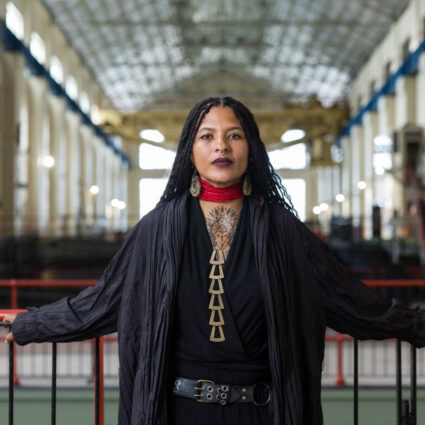“Uncharted” is a new interview series created in light of the COVID-19 pandemic. We’re talking to people in the New Mexico arts world and beyond to see how the community is navigating this unprecedented health crisis. This interview had been edited for length and clarity.

Rachel Popowcer
Artist and part-time faculty at Central New Mexico Community College
Daisy Geoffrey: What’s your current mood?
Rachel Popowcer: Isn’t it funny how that changes every day? I just exercised so it’s better right now—that saves my life, honestly. I don’t generally like the unknown, that can be frightening, but I always say I’m an optimistic realist. I’m trying to be optimistic. Today, I would say my mood is pretty good, but I think that also directly has to do with me working, that I was painting last night. That’s helpful for me.
What does art do for you at this time?
I’ve been playing kind of small more recently, especially since I’ve been done with grad school. I have a smaller space to work in where I’ve done smaller work and haven’t necessarily done the things that I’ve wanted to because of worrying about space, worrying about sales, worrying about where I’m going to show it, and how I’m going to do it. So during this time I’ve been thinking, you know, everyone could die! I might as well do what resonates, what is meaningful to me, and what I really love. So I started working on these huge pieces. It has felt really good. It’s that idea of, if not now, when? Weirdly, this horrible time has forced me to prioritize and get back to what I actually want to do and not worry about what’s going to happen with it.
The response I’ve gotten to the things I’ve been working on during this time has been really strong. When you do what you really want to do, what really resonates, people are going to respond to that the most.
Weirdly, this horrible time has forced me to prioritize and get back to what I actually want to do and not worry about what’s going to happen with it.
Is there anything you want to communicate with your work at this time?
I’m sitting in the middle of these enormous paintings I’m working on right now. They’re both about things being hidden underneath, coming to the surface, and promoting growth. They are really about things going on right now, which is the idea that our country is seeing all the problems that have been here that people have tried to either push under the rug or not listen because we have so many distractions. And now everyone is forced inside. These paintings I’m working on have these conceal-and-reveal types of things. I paint a lot that I then cover. The idea is that you can take that hidden stuff—it doesn’t mean that you have to share it—but you learn from it and you grow and create something better, something different.
A lot of my paintings have to do with a chaos/control element, which is the environment we’re in now. Ultimately a lot of my work has to do with my personal lifelong lesson that we can’t control any of it, we can’t. I just wrote an essay for a performance I did, and the last line was “The only thing that I can control is what I choose to create.” That’s something that’s really important to me in my work.

I’ve heard some harrowing stories about students who typically rely on the space, resources, and time away from home that school provides for them now having a difficult time completing their work digitally from home. Have you experienced this?
I had a student who had to drop all of her classes for summer because she’s in a rural area and she has to finish all of her school work on her phone. I’ve had other students contact me and say, “I know my work would be better in the class but I honestly don’t feel motivated at home, or my family situation is hard, or my family’s not supportive.”
If they’re not getting support at home and they can’t go to a class, it’s challenging.
Is there something that emerges in that greater amount of time spent together, when you’re there to receive and respond to things that they wouldn’t necessarily open up to when you’re communicating digitally?
One-hundred percent. When you’re communicating digitally, people are going to be more efficient, so they’re just going to tell you, “Here’s the work I’m turning in,” or ask, “Can you critique this for me?” When you’re in a three- or even six-hour class, they confide things all the time if they’re having issues. It creates a space for that that isn’t quite there in an online way.
You start to feel comfortable in the classroom setting.
When you reach students on a more emotional level, does that seem vital to the progression of their work and what they’re learning?
Yes, very much, that’s why I’m glad classes didn’t end at the beginning of the semester so that I was able to build that kind of trust and community with my students. I think I get really good work from my students because I’m very hands-on and I care about them, so they know I have expectations of them and that I see their potential. When they know a teacher cares, and notices them and sees them, I think that makes a massive difference in the quality of work and engagement from the students.
Do you find consuming online content useful for yourself right now?
As far as being an artist, sometimes it can be detrimental to play the comparison game, to look online at what everyone’s doing. What I do like is that I don’t always like to go out, I really love to make work. I like to sell work, talk about it, and show it, but in a weird way it feels this [pandemic] has almost leveled the playing field, so I don’t have to go out to art openings, I don’t have to worry about schmoozing or being seen.
It hasn’t been horrible having to represent myself only digitally during this time, because I love composition and color and photography, so whether it’s photographing my own artwork, or showing what I’m doing during the day, or making these videos for my students or whoever wants to learn from how I do things, it’s something I enjoy doing. Although right now, I’d probably kill to go to an art opening and hug people!
What is the role of art in a time of crisis?
It’s everything. Imagine if we had no literature, no art on the walls, no art to do at home, or no podcasts to listen to. Everything that people are doing at home is artistic. Whether it’s cooking, reading, painting, or crafting, I feel like the role of art has always been to bring joy, to bring healing, to stimulate your brain. For me, my favorite thing (especially because I don’t paint still life or what’s in front of me, I paint out of my head) for me it’s always problem-solving. It makes me feel like I’m doing something, like I’m figuring out things, it gets my brain working. It makes people feel good, ultimately. No matter what you’re doing. I almost feel more of a need for the consumption of artistic pursuits right now.

What part of going to museums and galleries are you looking forward to most, that you can’t get from looking at art online?
Seeing work in person. When I go to a gallery or museum, I’m that person—I stick my face right up to the painting, I look at the side of it, I want to touch it when people aren’t looking. I think with painting it translates differently. I miss seeing work in person so I can really get a sense of the essence of it, and the truth of it.
What an unexpected challenge you’re facing?
I have three kids, so I have to make sure I’m here for them and taking care of them. But it’s funny how what you think is not a great thing turns out to be a positive thing in a time of crisis— my studio has always been at home because it has to be, and that has turned out to be a super plus, so nothing has changed as far as how I work. Having my kids here all the time is a lot, but I’m doing it!
Where are you finding joy at this time?
I normally find it being outside, so I feel like I find joy when I can go outside and take a walk or sit in the sun or breathe, and when I can paint. Painting makes me feel so good if I feel like I’m getting something done. And like I said, when I’m painting, I’m problem-solving. There’s that part that’s for me and not for anybody else. That makes me feel really happy.



